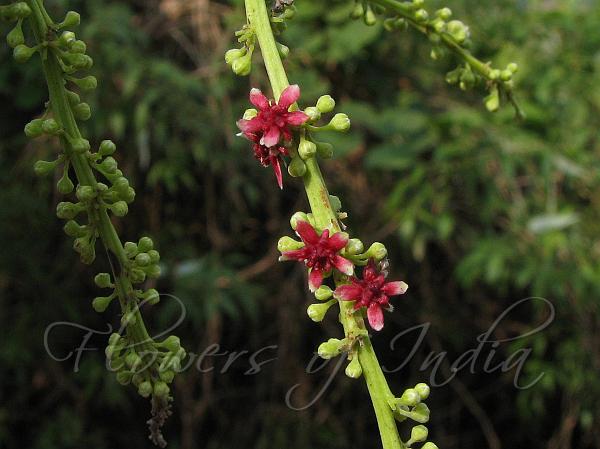|
| Ceylon Homalium |
|

|

| File size | 448922 |
| Original date | 3/16/13 9:59 AM |
| Resolution | 1840 x 1380 |
| Flash | Flash did not fire, auto |
| Focal length | 6.0mm |
| Exposure time | 1/400s |
| Aperture | 5.6 |
| Focus Distance | |
| Metering Mode | Multi-segment |
| Camera make | Canon |
| Camera model | Canon PowerShot S5 IS |
| Sensor type | OneChipColorArea |
|
|
|
|
Photo: |
Botanical name: Homalium ceylanicum Family: Salicaceae (Willow family)
Synonyms: Blackwellia ceylanica, Homalium zeylanicum, Blackwellia zeylanica
Synonyms: Blackwellia ceylanica, Homalium zeylanicum, Blackwellia zeylanica
Ceylon Homalium is a trees, 6-30 m tall,
buttressed. Bark is smooth to coarse; branchlets brown, angular to
terete, puberulous to glabrous. leaf blade variable in shape and size,
elliptic to oblong, rarely obovate, 6-18 x 2.5-8 cm, thinly leathery to
thickly papery, abaxially pubescent with appressed short hairs or
glabrous, hairless above, midvein raised below. Flower racemes occur
in leaf axils, and are pendulous, 5-20 cm. Flower-stalks are 1-3 mm,
articulate at or above middle, densely puberulous to appressed shortly
pubescent. Flowers numerous, in fascicles of 3 to about 20, sometimes
very crowded along rachis, reddish or whitish, 4-6-merous, 2.5-3 mm in
diameter at anthesis, fragrant. Sepal tube is 0.5-1.5 mm, sparsely to
densely pubescent, hairs whitish, appressed, 0.1-0.2 mm, sepals
linear-oblong or spatulate, 0.5-2 x 0.3-0.5 mm. Petals are whitish or
pinkish, ovate-oblong or spatulate, 0.8-2 × ca. 0.6 mm, both surfaces
densely hairy, sometimes more so than sepals, margin densely
white-ciliate, tip blunt. Stamens are 4-6, filaments 2-3 mm, glabrous;
anthers ca. 0.4 mm. Ceylon Homalium is found in Bangladesh, India,
Laos, Myanmar, Nepal, Sri Lanka, Thailand, Vietnam.
| Identification credit: Shrikant Ingalhalikar | Photographed at Karikan near Kumta, Karnataka. |
• Is this flower misidentified? If yes,